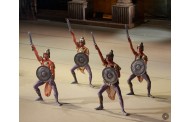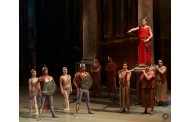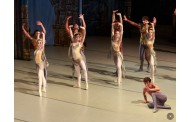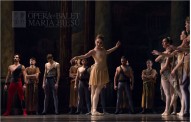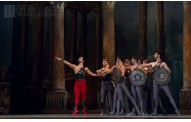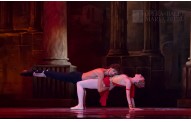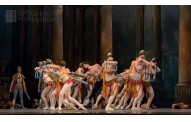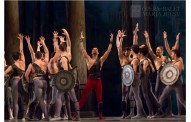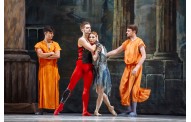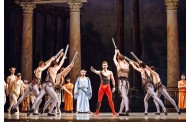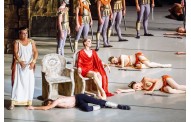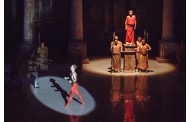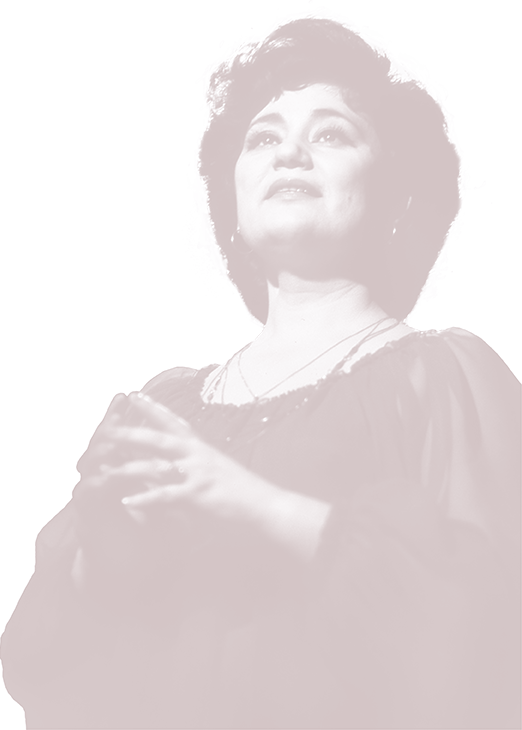
ACT I
Scene I – Triumph of Rome
Victorious legions led by the Roman consul Crassus return to Rome from their latest conquests in a triumphal procession. The crowd welcomes the troops coming under the solemn march sounds.
Behind the legions are the captives. Among the captives are the Thracian king Spartacus and his wife Phrygia. Spartacus protects the prisoners from carousing crowd.
Scene II – The Slave Market
Intoxicated by the joy of victory, the soldiers and the girls, walking on the streets of Rome, turn up on the market square. There is a sale of slaves. They force a Greek slave to dance.
The owner of the gladiator school buys Spartacus and his friend - Harmodius. At the slave market appears Crassus with his concubine Aegina. Bewitched of the beauty of Spartacus, Aegina asks Crassus to buy the Thracian king, and also Harmodius. Spartacus is parted from Phrygia. Inconsolable Phrygia, recalls the happy days spent with Spartacus.
Scene III – Aegina’s Chambers
Aegina brings Spartacus and Harmodius to her chambers, hoping to satisfy her passion. But Spartacus is implacable: he would never be unfaithful to Phrygia. Enraged Aegina calls the lanista and asks him to send Spartacus and Harmodius to the gladiator school.
Scene IV - Crasuss’s Villa
Insulted Aegina cannot calm down. Crassus tells her that only the blood of gladiators will calm her. The gladiators are brought to the arena and Aegina choses Spartacus, Harmodius and the Greek slave who must engage in a fight to death.
There is a fierce battle in which Harmodius and the Greek slave get injured. Aegina orders Spartacus to kill the both injured gladiators, but he refuses. Crassus orders Spartacus to continue the fight with the remaining gladiators.
Scene V – Spartacus’s monologue
Spartacus is immersed in heavy thoughts. His despair develops into anger and protest. He will no longer tolerate captivity. He thinks that is better to die on the battlefield then on the circus arena for the amusement of the romans. He has but one choice of action — to win back his freedom.
Scene VI – The Rebellion
In the barracks of gladiators, in the hands of Spartacus dies the Greek slave wounded by him. His death was the last straw. Spartacus incites the gladiators to revolt. They break out of the barracks to freedom and hide in the darkness of the night.
ACT II
Scene I – Spartacus’s Camp
Freed gladiators dance together with Spartacus an exultant war dance. All of them swear an oath of loyalty to Spartacus.
Scene II - Conspiracy
Trying to disorganize Spartacus’s camp, Crassus sends to them Aegina and the courtesans.
Scene III - Dissension
Aegina executed Crassus’s order: Harmodius is completely at her mercy. Enraged Spartacus requires that women to leave the camp, but it is too late. Harmodius and a part of the troops leave the camp with Aegina and the courtesans.
Scene IV - Aegina’s Chamber
Aegina „rewards” Harmodius for his betrayal.
Scene V – Crassus’s Feast
Aegina triumphs, luck accompanies her everywhere. Everyone is having fun. Crassus suggests Aegina to bring Harmodius at the feast to fully enjoy his crash. Harmodius is brought to the feast and „asked” to dance with courtesans. Harmodius gets more and more drunk with his happiness, but Crassus brings him back to reality showing him his wounded friends. Everything is lost. Crassus orders the death of Harmodius. Roman infantry heads to Spartacus's camp.
Scene VI – Before the battle
Spartacus and Phrygia say goodbye to each other before the decisive battle. Roman soldiers appear suddenly, headed by their general and ask Spartacus to leave his army and pass to the side of Romans. Enraged, Spartacus chases away the general, handling him a sword for Crassus, declaring that he wants to fight. Phrygia is suffering, predicting death ...
Scene VII – Spartacus’s Death
A fierce fight begins. Spartacus fights on fearlessly, but the powers are unequal.Spartacus is slained and dies.
Prhygia mourns her beloved, her grief is inconsolable. But the brave appearance of Spartacus will always remain a symbol of freedom.
Conductor:
Libretto: Nicolai Volcov
Edited by Igor Chernysov, Russia
After the novel "Spartacus" by Raffaello Giovagnoli
Choreography: Igor Chernysov, Russia
Choreographic adaptation: Natalia Korotkova
Scenography: Iurie Matei, People's Artist
Costume painter: Anastasia Spătaru
World premiere: December 27, 1956, at the Opera and Ballet Theater „S. M. Kirov ”(now the Mariinsky Theater) staged by Leonid Iakobson.
Premiere in Chisinau: 1975, at the Moldovan State Theater of Opera and Ballet, staged by I. Chernysov
The premiere of the current version: June 24, 2016, at the “Maria Bieșu” National Opera and Ballet Theater
Duration of the show: 2.00 h. (two breaks)

